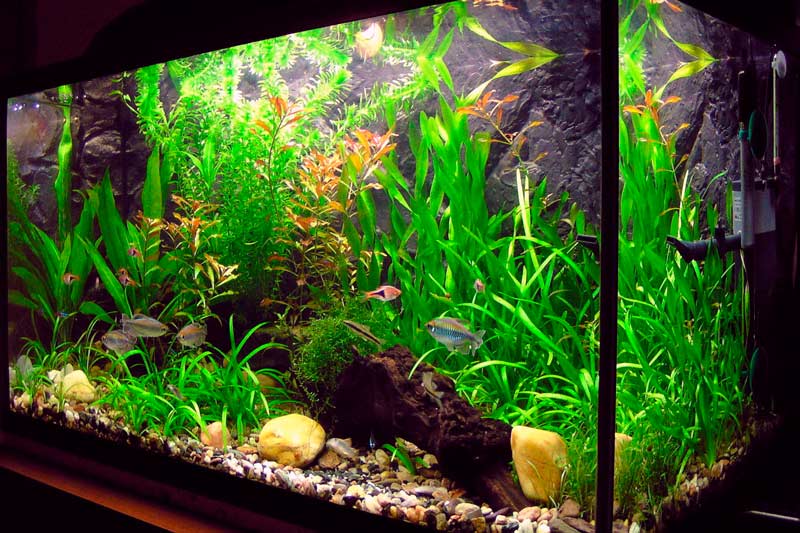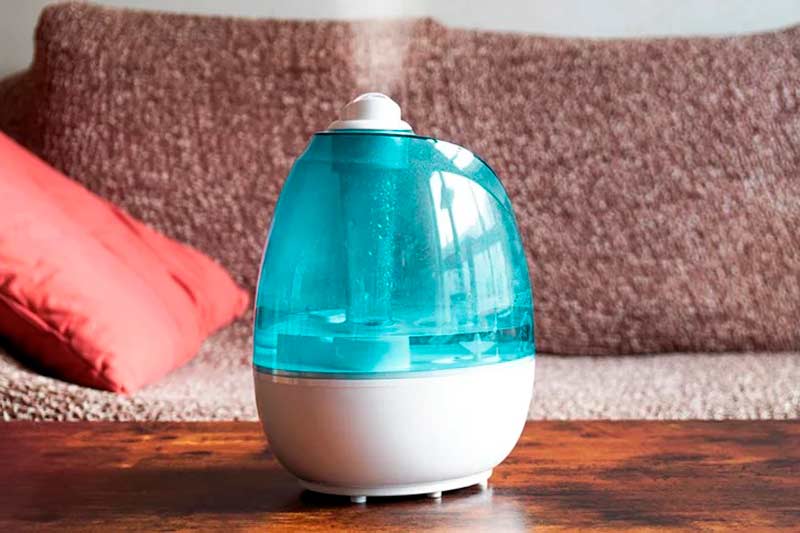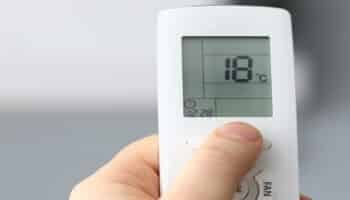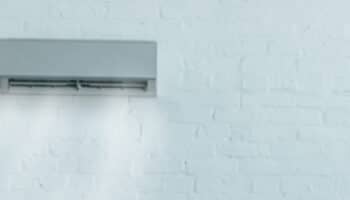We've independently reviewed this article to make sure it's as accurate as we can make it.
To find out more about our article creation and review process, check out our editorial guidelines.
Air Conditioner Air Too Dry? Follow These 7 Easy Steps
Did you know your air conditioner is essentially a giant dehumidifier?
Every moment your air conditioner is running—the compressor and the fan, not just the fan—it’s pulling moisture from the air, often making it too dry. Some things you can do to help include a humidifier, leaving the bathroom door open when you shower, turning off the range fan when cooking, and more.
The following will provide an in-depth explanation for your dry air and discuss multiple things you can do to add some moisture back into your environment—and why you should!
If that sounds good, let’s dive in.
What You’ll Need
I suggest trying each of the methods listed below at least once to determine what works best for you. To do so, you’ll need:
- Water
- Containers—pots or bowls
- Towel
- Sponge
- House plants
- Indoor water fountain
- Fish tank
- Humidifier
If Your Air Conditioner is Drying Out Your Home, Try…
Depending on your needs, likes and dislikes, and even your environment, some of these might work better than others. As already suggested, try several that you think may work for you, and stick with one—or more!—that you like the best.
A word of warning, though. Many of these won’t have lasting effects. You’ll gain some humidity for a while, but it will burn off fairly quickly. So if you are settling on a few different options, try to choose something short-term along with something long-term. I’ll be sure to indicate that with each suggestion.
If you keep your air conditioner running all season, you should consider long-term options.
Hang or Lay Your Clothes to Dry Inside
- Short to Medium-Term Benefits

How often is laundry day in your household? Consider air drying some of your clothes inside. For the time they are drying, they’re adding moisture to your air.
This tip has a few benefits. It may help cut down a bit on your energy costs—the dryer is expensive to run!—while adding some humidity.
But a word of warning. Only dry your clothes inside when you know your humidity is low. Adding too much moisture can lead to mold growth and health problems.
Cook on the Stovetop
- Short-Term Benefits

The trick here is to cook with the range fan off. When it’s on, it’s pulling all that moisture outside.
Every time you boil a kettle—stovetop or electric—you can see all that steam clouding up the air. So when you’re cooking, especially boiling water for pasta, potatoes, or poached eggs, you get the idea, let all that humidity linger in the air. However, depending on the size of your home, and whether or not you have an open-concept floor plan, it may not get much farther than the kitchen.
And the longer something boils, the more water it will add to your air, so keep that in mind. But also be mindful of the cost to run your stove.
Many electric stovetop burners run from about 1,200 watts for the smaller burners to about 3,000 watts for the large burners. Compare that to the average humidifier that runs at about 11 watts.
It might be smart for you to do a cost analysis of how much it would cost you to leave a pot of simmering water on the stove for x amount of time compared to the cost of purchasing and running a humidifier.
Shower With the Bathroom Door Open
- Short-Term Benefits

Whether you like to linger in a long hot bath or a shower, let all the steam that’s created escape the bathroom and into your living areas. Just be sure not to turn the bathroom fan on when you do.
As you probably know, the bathroom collects a lot of moisture, so don’t trap it in there when you’re dealing with low humidity issues.
The only drawbacks are that the benefits are short-lived and you’re not doing much to raise humidity levels throughout the house.
Get a Fish Tank
- Long-Term Benefits

A fish tank will add humidity to your air all year round. So in those winter months when it’s typically dry, you’ll have some extra humidity too.
But sometimes too much of a good thing isn’t a good thing.
The larger the tank, the more water evaporates into your air every day. So keep the following in mind, since too much humidity can lead to mold, mildew, and respiratory problems. For example, a 50-gallon fish tank will evaporate one gallon of water a day, which, if not managed properly, could push your humidity levels past what’s recommended.
Placement is another factor. If you put the tank in a place that gets plenty of airflow—and is healthy for the fish—you can spread the humidity throughout your home. You could even strategically place small fans to help with that.
Use Indoor Water Fountains
- Long-Term Benefits

There are a lot of benefits to an indoor water fountain! They add humidity to your air, they provide some pleasing white noise, and they can help you relax and de-stress.
The amount of humidity an indoor fountain will provide depends on several factors, including the size of your home, how much airflow you have in the area where you have the fountain, and the amount of water flowing.
Indoor fountains have very low wattage. Typically about 10 watts, so very close to the wattage of the average humidifier. And they’ll provide humidity as long as they have running water.
Use Large Sponges
- Long-Term Benefits
A sponge certainly isn’t as aesthetically pleasing as a water fountain or fish tank, but it will provide the same long-term benefits, for less money and less work.
A few large, carwash-size sponges placed around your home can provide a significant amount of humidity. The sponges hold a lot of water and take a long time to dry.
Since some of the water will seep out of the sponge wherever you have it sitting, it’s important that you place it on something that will collect whatever water drains out without damaging the surface. Simply monitor how long it takes for all the water to evaporate, and then soak it up again accordingly.
Get a Humidifier
- Long-Term Benefits

Of course, the simplest thing to do is buy a humidifier. Depending on the size, they can cost at least a few hundred dollars, and then there is the cost to run them—however, operating costs are typically low.
As far as size goes, you can buy small desktop humidifiers for a single room or large, whole-home humidifiers.
Why Is Air Conditioned Air so Dry?
Now that you have a solid grasp on what you can do to add some humidity back into your air, let’s briefly discuss why your air is lacking humidity in the first place.
As mentioned at the outset, an air conditioner is essentially a large dehumidifier — at least to some extent. While they do dehumidify the air, they won’t do it as efficiently as a dehumidifier will, because that is not their primary purpose. You could say that dehumidification is simply a side effect of running your air conditioner.
So what’s really going on?
As refrigerant runs through your air conditioner’s evaporator coil, it cools the air in your home. While it’s doing this it’s also absorbing the heat from your home. Then the refrigerant moves to the compressor and the heat that’s collected is released outside.
This process happens whether you have central air, a window air conditioner, or portable air conditioner.
But the air that surrounds the indoor evaporator coil is cold and condensation forms on it during this process. That condensation is collected—along with the humidity in your air—and drained from your home.
It’s Important to Maintain Healthy Humidity Levels in Your Home
According to the Mayo Clinic, you should keep indoor humidity levels between 30 and 50%.
Not enough humidity or too much humidity can have an adverse impact on your health. So if your humidity is low thanks to your air conditioner, it’s important to raise it. However, you need to be careful not to raise it too much.
If your indoor humidity drops too low, it could bring on the following symptoms and sicknesses.
- Cracked lips
- Dry itchy eyes
- Dry skin
- Frequent coughing
- Irritated nasal passages
- Nosebleeds
- Sinus headaches
- Sore throat
And it’s not just your health that is impacted. If the humidity in your house is too low, the air will suck up moisture wherever it can find it. Any wood in the structure of your home or your furniture becomes a source of moisture. It will eventually dry out completely, and then crack and shrink — damaging your home and your furniture.
Too much humidity is just as bad.
When there’s too much water in the air condensation will collect on windows, wet stains can appear on walls and ceilings, and eventually, mold will grow.
Just like a lack of humidity can cause structural damage, high humidity will do the same thing. And while it’s damaging your home, it’s damaging your health as well. Prolonged exposure to mold spores can lead to the following.
- Watery eyes
- Runny nose
- Sneezing
- Itching
- Coughing
- Wheezing
- Respiratory problems
- Headaches
- Fatigue
So choose one of the options listed above to add humidity to your home, just be careful not to add too much.
Conclusion
As we’ve discussed, there are a number of things you can do to add humidity back into your home when running an air conditioner of any kind. We’ve made several suggestions, but this is not an exhaustive list.
To recap, you can try any of the following:
- Hang or lay your clothes to dry inside
- Cook on the stovetop
- Shower with the bathroom door open
- Get a fish tank
- Use indoor water fountains
- Use large water-soaked sponges
- Get a humidifier
If you have a different idea, try it out. And you can always get a hygrometer to test how well different solutions work in your environment.
As always, we hope you found the answer to your question. While you’re here, why not take a look at some of the related posts listed below? Perhaps we can help you with something else.







